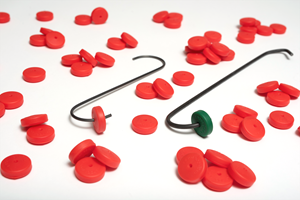E-coat Paint Shrinkage
What is the true meaning of shrinkage in electrocoat paint?
Q. We hear different answers depending on who we ask. Could you tell us what is the true meaning of shrinkage in electrocoat paint? Do all electrocoat formulas shrink in the same measured level? What variables influence shrinkage the most? —F.G.
A. Shrinkage in an electrocoat material typically refers to the percentage of the initial weight of dry electrocoat material that is lost in the oven during the crosslinking (polymerization reaction or curing) of the electrocoat. Ten percent shrinkage means that, for each 90 mg of electrocoat on the finished part, you need to apply 100 mg in the electrocoat bath.
Theoretically, expected shrinkage can be calculated based on a given crosslinking temperature and amount of time. Most times, the shrinkage is calculated by coating panels with electrocoat paint and weighing them before and after oven curing at the temperature and time used for the specific line. The level of film thickness used to coat the panels or coupons do not affect the shrinkage value, as it is measured as a ratio and expressed as a percentage.
The maximum temperature reached during curing is the most important variable influencing shrinkage. Weighted time at multiple curing temperatures is the second most influential factor. Another tertiary factor is the paste/binder ratio (p/b) of the bath. Not all electrocoat materials shrink the same way or by the same percentage.
Typical epoxy electrocoat resins are made up of unreacted monomers that, during polymerization in a heated oven, combine and intertwine to form long and strong polymeric chains with high molecular weight. This intertwined polymer chain provides the finished electrocoat its chemical, mechanical and corrosion-resistance properties, and its overall durability.
The shrinkage or weight loss of the electrocoat is generated when functional materials called “blocking agents” are released in the oven after they reach a predetermined temperature. These blocking agents typically are incorporated into the electrocoat formula as partially reacted with the epoxy monomers. This formulation approach prevents the monomers or paint from crosslinking at lower temperatures than desired and extends product stability. If a certain cure temperature is not reached in the oven, the applied electrocoat will not release any blockings agents or initiate any crosslinking, and therefore will remain 100 percent uncured. When the formulated temperature is reached, the blocking agents are released and the polymerization reaction progresses until the e-coat gradually reaches 100 percent cure.
Typically, the coating lost by shrinkage is through the oven’s exhaust fan. Excessive ecoat shrinkage can lead to excessive build-up of brownish, resinous material in the exhaust stacks and oven panel joints, and can contribute to visible smoke emissions and odors in neighboring properties.
Since shrinkage refers to a loss in material, it is important to select electrocoat materials that provide low shrinkage across multiple cure temperatures and times. Shrinkage in the range of 5 to 15 percent is typical with current electrocoats formulations and under typical cure conditions.
Also keep in mind that shrinkage values increase rapidly with increases in oven temperatures, so try to avoid elevated cure temperatures your ovens.
Related Content
Sustainability, Electrification and Mobility
Industry events like ECOAT are good indicators of the trends that are top of mind for those in manufacturing.
Read MoreCFS Unveils New Hook Locks Parts Racking Solution
New product from Custom Fabricating & Supplies (CFS) prevents part loss during coating processes.
Read MoreInstalling an Ecoat Line
Thinking of investing in electrocoating capabilities? George Lovell, coatings plant manager for Lippert, discusses considerations you should keep in mind as you add your ecoat line.
Read MoreTTX’s Automated Conveyor Carrier System Offers Wireless, Flexible Operation
ACC system designed for reliable, consistent point-to-point movement of everything from small to heavy parts.
Read MoreRead Next
Episode 45: An Interview with Chandler Mancuso, MacDermid Envio Solutions
Chandler Mancuso, technical director with MacDermid Envio discusses updating your wastewater treatment system and implementing materials recycling solutions to increase efficiencies, control costs and reduce environmental impact.
Read MoreA ‘Clean’ Agenda Offers Unique Presentations in Chicago
The 2024 Parts Cleaning Conference, co-located with the International Manufacturing Technology Show, includes presentations by several speakers who are new to the conference and topics that have not been covered in past editions of this event.
Read MoreDelivering Increased Benefits to Greenhouse Films
Baystar's Borstar technology is helping customers deliver better, more reliable production methods to greenhouse agriculture.
Read More







.jpg;maxWidth=300;quality=90)
















